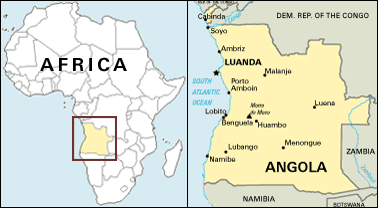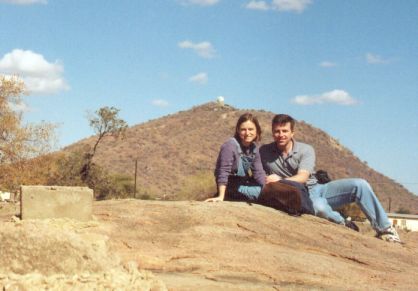In the time since our last entry, we arrived safely to Luanda, Angola’s capital, where we had a very productive few days. We then flew south to Lubango, where we were very warmly greeted by many of the individuals we’ll be working with over this year. This helped tremendously in our transition to our new home. The afternoon of our arrival we traveled an hour out of town via Land Cruiser up a bumpy mountain road to a place called Tundavala. It is often referred to, locally, as the Eighth Natural Wonder of the World. Here the great Central African Plateau (which spreads through several countries) drops off almost a mile down to the coastal plain below. On a clear day, you can just catch a glint of the Atlantic Ocean 100 miles away…
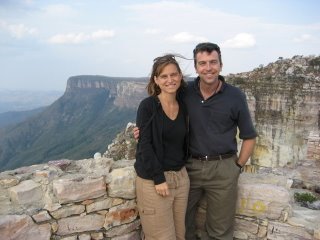 The view from Tundavala
The view from Tundavala
Lubango is a city of about 300 thousand people. Tens of thousands of these arrived during the years of the civil war, displaced from their homes by the fighting. Most of these now live in the many bairros composed of mud-brick or cement-block homes that surround the city center. The city is located at 5200 feet altitude, and surrounded on three sides by cliffs measuring an additional 900 feet. Our hospital is at the top of one of these escarpments.
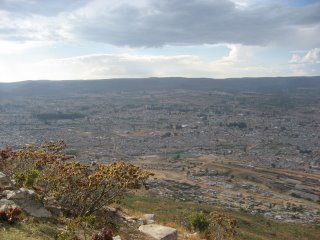 Lubango as seen from the bluffs
Lubango as seen from the bluffs
Our arrival in Lubango happened to land exactly a week before the opening of the hospital. This was not intentional on our part, but some would say the timing was providential. We spent the first week helping with arranging of the clinics and the operating rooms. We discovered all sorts of things in storage… One of our happiest moments was discovering that we had shipped a brand new polished chrome set of urethral dilators donated by Vanderbilt’s student-run equipment salvage organization, allowing us to throw out the rusty 1940s set we had been trying to salvage. I think our patients will be even happier! Plenty of stricture disease around here.
This past Monday, October 16, 2006 saw the opening of the Evangelical Medical Center of Lubango, (Centro Evangélico de Medicina do Lubango, heretofore CEML). The day started with a brief thanksgiving service and a tour to orient patients and invited guests alike. We then jumped right into clinical duties.

The crowd at the thanksgiving ceremony

Steve (Medical Director), Daniel (Head Administrator), Pastor Moises (Chairman of the Board), and Cesar (Financial Director)
CEML currently has 4 physicians (including me and Beth), about ten nurses (half of whom have administrative roles), a handful of administrative staff, and several auxiliary staff members. We are currently running clinics only, with one day per week for procedures (cystoscopy, GI endoscopy, and laryngeal polypectomy this past week). We will open for inpatient care (40 beds currently) early in November. At that time we will also open up the general and ophthalmology operating rooms.
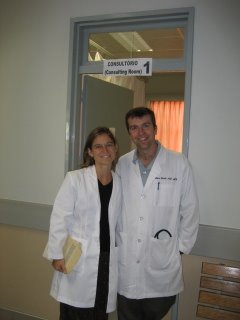 First day of patient care
First day of patient care
We are very grateful to say that the first week of the hospital has come and gone, all things considered, quite well. We saw 75 patients our first day. All of these interviews were conducted in Portuguese. By the end of the week, Beth and I were each seeing patients on our own in Portuguese (our patients are fortunately very gracious with us), or in a local language (mainly Mbundu and Nhaneca) through a translator. There are a tremendous number of challenges ahead… reliable transportation, reliable energy supply, training of nursing staff, budgetary concerns, to name a few. However at the end of the week, we have much to be thankful for, and we look forward to what is yet to come.
As many of you know, a significant portion of our funding for this year has come through a Vanderbilt Medical Scholars research grant and an educational grant through the U.S. State Department Fulbright committee. The educational encounters in this last week are almost innumerable. At our next Blog entry, we will present a few of our most interesting cases. However, to give a taste, here’s a list of some of the diseases our patients are suffering with:
Things we are used to treating:
- Uncontrolled hypertension
- Basal cell carcinoma of the face
- Fibroadenoma of the breast
- Obstructing chronic gastric ulcers
- Obstructing gastric cancer
- Giant varicose veins
- Chronic constipation
- Irritable bowel syndrome
- Anal fissures
- Fistula-in-ano
- Imperforate anus
- Benign prostatic hypertrophy
- STDs
Things we are not so used to treating:
- Malaria
- Leprosy
- Hydrocephalus
- Advanced retinoblastoma
- Giant goiters
- Obstructing laryngeal polyps
- Near-obstructing chronic tonsilitis
- Multi-drug resistant tuberculosis
- Undiagnosed abdominal masses without CT scans
- Deforming burn contracture
- Osteogenic sarcoma
- Osteomyelitis with sequestra
- Clubfeet
- Poliomyelitis
- Chronic lymphedema leading to elephantiasis
- Acute urinary retention and renal failure caused by benign prostatic hypertrophy
- Giant hydrocele
- Cystocele
- Locally recurrent cervical cancer
- Strongyloidiasis
- Amebiasis
- And the ever present “wandering snake syndrome”… best treated with a lot of bran and reassurance
For those who are the praying sort, please be praying for:
- Continued growth and deepening of our relationships with the hospital staff
- Hope and healing for our patients
- Cultural and linguistic adjustment for us
- The administrative leadership of CEML, that the hospital will be a stable institution, serving this region of Angola, including our poorest neighbors
Finally, for those who may not be aware… the rainy season has started with full force here in Southern Africa. Consequentially, Beth and I are now heading to our kitchen to stem the incoming tide of water. Until next time!
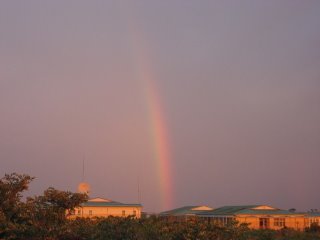
Rainbow over CEML, at the end of our day: hope and health

